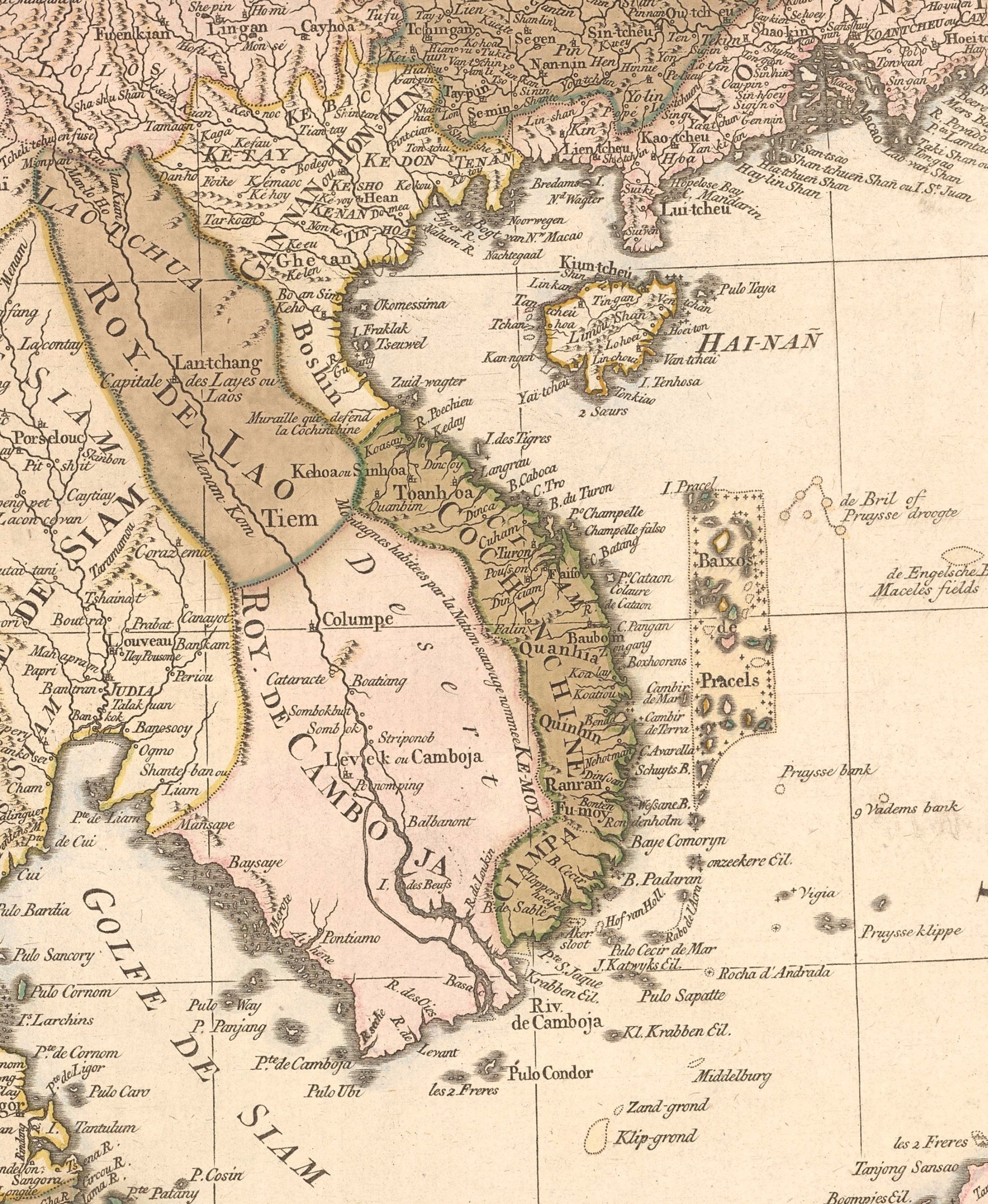|
Battle Of Rạch Gầm-Xoài Mút
Lê Văn Duyệt Lê Văn QuânNguyễn Văn Thành Nguyễn Văn Oai Mạc Tử Sinh , units1 = Tây Sơn Army , units2 = Siamese Army Siamese Navy Nguyễn Ánh's forces , strength1 = 30,000 men55 warships100 sailing ships300 small canoes132 cannons , strength2 = Siamese-Cambodian: 20,000 sailors30,000 infantryTucker, p. 15300 warships3,000–4,000 Nguyễn Ánh's forces , casualties1 = Unknown, but presumably much less than opponent , casualties2 = Warships: near annihilationClodfelter, p. 7Dutton, p. 45–46Siamese-Cambodian soldiers: 40,000+ killedNguyễn forces: 3,200 killed, The Battle of Rạch Gầm-Xoài Mút ( vi, Trận Rạch Gầm – Xoài Mút, th, การรบที่ซากเกิ่ม-สว่ายมุต) was fought between the Vietnamese Tây Sơn forces and an army of Siam in present-day Tiền Giang Province on January 20, 1785. It is considered one of the greatest victories in Vie ... [...More Info...] [...Related Items...] OR: [Wikipedia] [Google] [Baidu] |
Tây Sơn Wars
The Tây Sơn Rebellion was a massive peasant rebellion and an interregnum in the late eighteenth century Dai Viet (present-day Vietnam) against the ruling Vietnamese elites and monarchs, during the context of a 250-year-long disintegration period. The rebellion was led by three Tayson brothers, Nguyễn Nhạc, Nguyễn Huệ, and Nguyễn Lữ, who eventually overthrew all ruling clans and the reigning Lê dynasty in southern and northern Dai Viet. Background By the mid-18th century, the Dai Viet kingdom had been fragmented for 200 years. The ruling Lê dynasty monarchs stood as the figurehead of the nation, while Trinh lords in Tonkin and Nguyen lords in Cochinchina were the actual rulers on their own domains. The population expanded to over 7.2 million by the 1740s. European trade to Tonkin was suspended in 1700 while trade in Cochinchina also declined, causing major decreases in revenues for both the lords and their domains. Drought, famines, diseases (smallpox) were fr ... [...More Info...] [...Related Items...] OR: [Wikipedia] [Google] [Baidu] |
Chaophraya Aphaiphubet (Baen)
Chaophraya Aphaiphubet (Baen) ( th, เจ้าพระยาอภัยภูเบศร (แบน), km, ចៅពញាអភ័យធីបែស បែន, ?–1811), also known as Chaofa Talaha (Baen) ( km, ចៅហ្វាទឡ្ហៈបែន, th, เจ้าฟ้าทะละหะ (แบน)) or Chau Hua Pen ( km, ចៅហ្វ៊ាបែន), was a Cambodian officer, later a Siamese governor. He was known in Vietnamese contexts as Chiêu Thùy Biện (昭錘卞). Baen was a Khmer noble with the title Oknya Yomreach (, or ''Phraya Yommarat'' in Thai). In 1782, Baen and Oknya Kalahom (Suos) () captured the pro-Vietnamese regent Talaha (Mu) and had him executed. Soon Baen came into conflict with his ally, Suos. Baen assassinated Suos. Knowing Suos was killed, Cham rebels attacked Phnom Penh,ศานติ ภักดีคำ. เขมรรบไทย. กทม. มติชน. 2554. หน้า 272 forcing Baen, King Ang Eng and Oknya Kal ... [...More Info...] [...Related Items...] OR: [Wikipedia] [Google] [Baidu] |
Hồ Chí Minh City
, population_density_km2 = 4,292 , population_density_metro_km2 = 697.2 , population_demonym = Saigonese , blank_name = GRP (Nominal) , blank_info = 2019 , blank1_name = – Total , blank1_info = US$61.7 billion , blank2_name = – Per capita , blank2_info = US$6,862 , blank3_name = GRP ( PPP) , blank3_info = 2019 , blank4_name = – Total , blank4_info = US$190.3 billion , blank5_name = – Per capita , blank5_info = US$21,163 , blank6_name = HDI (2020) , blank6_info = 0.795 ( 2nd) , area_code = 28 , area_code_type = Area codes , website = , timezone = ICT , utc_offset = +07:00 , postal_code_type = Postal code , postal_code = 700000–740000 , iso_code ... [...More Info...] [...Related Items...] OR: [Wikipedia] [Google] [Baidu] |
Nguyễn Nhạc
Nguyễn Nhạc ( vi-hantu, 阮岳, died 1793) was the founder of the Tây Sơn dynasty, reigning from 1778 to 1788. From 1778 to 1788, Nguyễn Nhạc proclaimed himself Emperor Thái Đức ( vi-hantu, 泰德). In 1788 after his younger brother proclaimed himself Emperor Quang Trung, Nguyễn Nhạc resigned his Emperor title and declared himself as King of Tây Sơn. Nguyễn Nhạc and his brothers, namely Nguyễn Lữ and Nguyễn Huệ, known as the Tây Sơn Brothers, ended the centuries-long civil war between the two feudal families, the Trịnh Lords in northern Vietnam and the Nguyễn Lords in southern Vietnam, seizing reigning power from these groups and the Lê dynasty. Early life Born in Tây Sơn District, Quy Nhơn Province (modern Bình Định Province). Vietnamese historian Trần Trọng Kim described him as a courageous and clever man. He had two younger brothers: Nguyễn Lữ and Nguyễn Huệ. Their talents are highly appreciated by their martial ar ... [...More Info...] [...Related Items...] OR: [Wikipedia] [Google] [Baidu] |
Siamese Navy
The Royal Siamese Armed Forces (Thai: กองทัพหลวง) were the armed forces of the Thai monarchy from the 12th to 19th centuries. The term refers to the military forces of the Sukhothai Kingdom, the Ayutthaya Kingdom, the Thonburi Kingdom and the Early Rattanakosin Kingdom in chronological order. The army was one of the major military forces of Southeast Asia. With a reform into a new Western-style army in 1852, the Royal Siamese Army became a new European-trained military force. The Royal Thai Armed Forces are the contemporary military of Thailand. Organization The Royal Siamese Army was organized into three general tiers: the Palace Guards, the Capital Defense Corps, and the field levies. Only the first two were the standing military. They protected the sovereign and the capital region, and formed the nucleus of the armed forces in wartime. The third, the field levies or conscripts, were usually raised just prior to or during wartime, and provided manpower to ... [...More Info...] [...Related Items...] OR: [Wikipedia] [Google] [Baidu] |


.jpg)